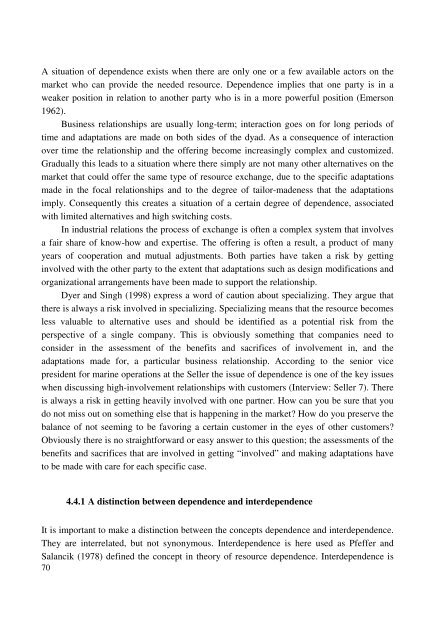Value Co-Creation in Industrial Buyer-Seller Partnerships ... - Doria
Value Co-Creation in Industrial Buyer-Seller Partnerships ... - Doria
Value Co-Creation in Industrial Buyer-Seller Partnerships ... - Doria
- No tags were found...
You also want an ePaper? Increase the reach of your titles
YUMPU automatically turns print PDFs into web optimized ePapers that Google loves.
A situation of dependence exists when there are only one or a few available actors on themarket who can provide the needed resource. Dependence implies that one party is <strong>in</strong> aweaker position <strong>in</strong> relation to another party who is <strong>in</strong> a more powerful position (Emerson1962).Bus<strong>in</strong>ess relationships are usually long-term; <strong>in</strong>teraction goes on for long periods oftime and adaptations are made on both sides of the dyad. As a consequence of <strong>in</strong>teractionover time the relationship and the offer<strong>in</strong>g become <strong>in</strong>creas<strong>in</strong>gly complex and customized.Gradually this leads to a situation where there simply are not many other alternatives on themarket that could offer the same type of resource exchange, due to the specific adaptationsmade <strong>in</strong> the focal relationships and to the degree of tailor-madeness that the adaptationsimply. <strong>Co</strong>nsequently this creates a situation of a certa<strong>in</strong> degree of dependence, associatedwith limited alternatives and high switch<strong>in</strong>g costs.In <strong>in</strong>dustrial relations the process of exchange is often a complex system that <strong>in</strong>volvesa fair share of know-how and expertise. The offer<strong>in</strong>g is often a result, a product of manyyears of cooperation and mutual adjustments. Both parties have taken a risk by gett<strong>in</strong>g<strong>in</strong>volved with the other party to the extent that adaptations such as design modifications andorganizational arrangements have been made to support the relationship.Dyer and S<strong>in</strong>gh (1998) express a word of caution about specializ<strong>in</strong>g. They argue thatthere is always a risk <strong>in</strong>volved <strong>in</strong> specializ<strong>in</strong>g. Specializ<strong>in</strong>g means that the resource becomesless valuable to alternative uses and should be identified as a potential risk from theperspective of a s<strong>in</strong>gle company. This is obviously someth<strong>in</strong>g that companies need toconsider <strong>in</strong> the assessment of the benefits and sacrifices of <strong>in</strong>volvement <strong>in</strong>, and theadaptations made for, a particular bus<strong>in</strong>ess relationship. Accord<strong>in</strong>g to the senior vicepresident for mar<strong>in</strong>e operations at the <strong>Seller</strong> the issue of dependence is one of the key issueswhen discuss<strong>in</strong>g high-<strong>in</strong>volvement relationships with customers (Interview: <strong>Seller</strong> 7). Thereis always a risk <strong>in</strong> gett<strong>in</strong>g heavily <strong>in</strong>volved with one partner. How can you be sure that youdo not miss out on someth<strong>in</strong>g else that is happen<strong>in</strong>g <strong>in</strong> the market? How do you preserve thebalance of not seem<strong>in</strong>g to be favor<strong>in</strong>g a certa<strong>in</strong> customer <strong>in</strong> the eyes of other customers?Obviously there is no straightforward or easy answer to this question; the assessments of thebenefits and sacrifices that are <strong>in</strong>volved <strong>in</strong> gett<strong>in</strong>g “ <strong>in</strong>volved” and mak<strong>in</strong>g adaptations haveto be made with care for each specific case.4.4.1 A dist<strong>in</strong>ction between dependence and <strong>in</strong>terdependenceIt is important to make a dist<strong>in</strong>ction between the concepts dependence and <strong>in</strong>terdependence.They are <strong>in</strong>terrelated, but not synonymous. Interdependence is here used as Pfeffer andSalancik (1978) def<strong>in</strong>ed the concept <strong>in</strong> theory of resource dependence. Interdependence is70
















